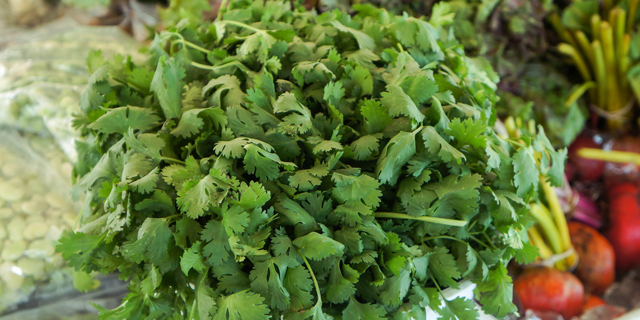Without cilantro, guacamole and salsa just wouldn’t be the same. Our beloved cilantro didn’t arrive on Latin American shores until 1670 when it was brought over by the British. Cilantro and coriander, cilantro seeds, have been used for thousands of years to treat headaches, infections and other ailments and today are used in a larger culinary sphere. High in antioxidants, fiber, vitamins K, C and A, as well as minerals including calcium, manganese, potassium and iron, cilantro and coriander are just as nourishing as they are delicious!
How do I pick the best cilantro?
At the market, choose a cilantro bunch that is bright and hearty. Stems should be stiff and crisp, leaves should be evenly colored and the bunch should show no signs of wilting, yellowing or drying out.
Cilantro can be grown in many conditions if you follow a few simple rules. Cilantro grows best from seeds. Plant seeds about an inch deep (in your plot or container) and water twice a week. Cilantro thrives with partial sun, so ensure that the plant has a little shade or plant cilantro close together so each plant helps shade the other. Once the cilantro flowers, cut off the flowers to encourage more herb growth. Harvest only half at a time so your cilantro keeps growing and provides you with delicious salsas and guacamole all summer long.
What can I make with cilantro?
We all know that cilantro is a must for any guacamole or salsa, but cilantro also lends itself to zesty pasta, black bean burgers and adds a refreshing zip to chicken dishes. Lemon juice and lime juice bring out the bright flavors of cilantro, which pairs perfectly with roasted fish or pan-fried shrimp.
Preparation is easy and quick. Wash the bit of cilantro you are going to use for your dish, pat dry and chop, mince or add whole to your dish. Fresh cilantro should be added last to to ensure it retains its bright coloring and intense flavor.
And storage? Cilantro should first be patted dry before any storage preparation. Cilantro can remain fresh for up to a week if stored in the refrigerator in a glass of water with ends trimmed. Stems should be trimmed and water should be changed every 2 days. Leaves can be frozen on a baking sheet, then transferred to a ziplock bag and will remain fresh for up to 6 months.
Recipes to try include: Ancho Cilantro Spring Chicken, Gluten-Free Lime Cilantro Crackers, Cilantro Vinaigrette Salad, Chicken Cilantro Soup, and Lime Cilantro Caraotas.


![Making Mealtime Matter with La Familia: Easy Sofrito [Video]](https://thelatinkitchen.com/wp-content/uploads/2015/10/sofrito-shutterstock__0-500x383.jpg)
![Easy Latin Smoothies: Goji Berry Smoothie [Video]](https://thelatinkitchen.com/wp-content/uploads/2015/12/goji_berry-shutterstock_-500x383.jpg)
















![Fun and Fast Recipes: Fiesta Cabbage Salad [Video]](https://thelatinkitchen.com/wp-content/uploads/2015/11/fiesta_cabbage_slaw-shutterstock_-500x383.jpg)









